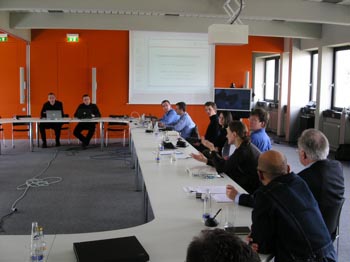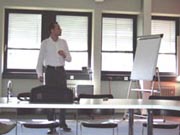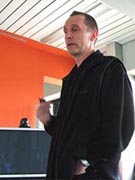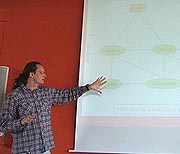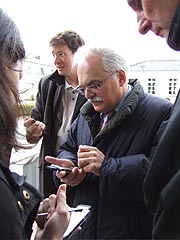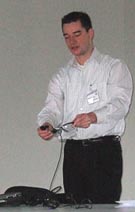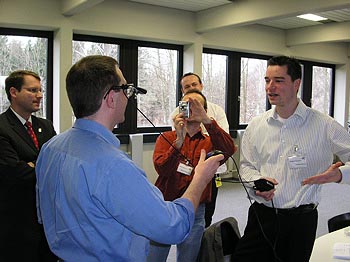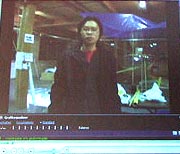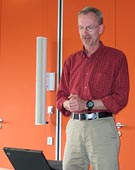workshop
The Story of Mobile Experience
Technology, content and structure for local based applicationsschedule
workshop
29.-30. March 2006
overview
schedule
participants
The programme allows for 4 sessions and 1 Demo slot.
Each session will have 3 presentations of 20 minutes and the possibility for about 45 minutes of discussion.
29. March
30. March
29 march 2006, DLR, WesslingAbstracts
Dr. Axel Küpper
The Next Generation of LBSs --- Functions and Challenges
Location-based Services (LBSs) automatically derive the geographic positions of one or several individuals in order to create, compile, select, or filter information and offer it to their users. Unfortunately, the first generation of these services, which was introduced at the turn of the millennium, never gained a significant market penetration. The reasons for the bad acceptance are manifold and range from the missing of accurate positioning technologies to a lack of competition and creativity in this field.
However, in the recent time the basic conditions for LBSs are changing. Mobile devices are increasingly equipped with GPS receivers for accurate self-positioning as well as with programmable environments like Symbian or J2ME for developing tailored and sophisticated LBS client applications. Furthermore, the strong engagement of research and development has created a number of key solutions like protocols, middleware, and positioning technologies, which are much more mature than comparable approaches a few years ago, when the first generation was launched.
Starting with a general overview of application areas and basic technologies, this talk identifies new LBS functions of the next generation, for example, proximity and separation detection and zoning, and shows how to realize them in an interorganizational supply chain of network operators and service providers. Furthermore, it gives an overview of mechanisms for saving the privacy of individuals being tracked and traced during LBS operation, discusses their pros and cons, and proposes alternatives to the classical mechanisms in this field.
download The Next Generation of LBSs (pdf; 2,6 MB)
top of page
Prof. KP Ludwig John, xinober
Context based experience
The world is full of sensations for all of our senses.
Digital media is just one small part of it.
With mobile devices there is the possibility to combine the best of both worlds - the physical and the digital - in order to create enhanced user experiences. The presentation outlines two examples of context based applications for mobile phone users, which have been realised at the university of applied sciences Augsburg.
download context based experience (pdf; 2,0 MB)
top of page
Prof. Dr. Georg Schneider
Towards Location Based Learning
The system MOVII (Moving Images and Interfaces) is an E-learning Platform, which has been developed with the participation of the Communication Design department of the Trier University of Applied Sciences. An Authoring and a sequencing tool are part of the framework in order to generate new content and to flexibly combine this content for the use in varying contexts, the so called learning paths. Especially for the visualization of the content structure and the navigation within this structure, MOVII offers many visually appealing tools. Furthermore MOVII supports different output media such as HTML, PDF, WAP, etc..
The future development of MOVII concerns the projection of these learning paths into the real world and to access the content based on the location of the user. Right now, most of the content in MOVII concerns fine arts and graphics design. Especially in a city like Trier, which is full of history, users/learners can see real world examples of many of the principles contained in MOVII. Consequently this extension helps for a better understanding of the learning content and it motivates to generate new content for location based scenarios that can be used vice versa e.g. in the context of a lecture.
download Towards Location Based Learning (pdf; 1,5 MB)
top of page
Katharine Willis
Navigation and wayfinding in urban environments using mobile devices.
Looking at how individuals acquire knowledge about the environment whilst moving through it, and the nature of such mobile contexts. I am particularly interested in how individuals cope with ambiguity in the presentation of information, arising out of GPS glitches and other such 'seams' between the contextual data arising out of the environment, the device and the individual. I make some proposals for how the nature of the design of the interaction needs to be re-considered to better accommodate such 'seams'. I am also currently undertaking a study with human participants where I will look at the nature of spatial knowledge acquisition acquired from mobile maps. I hope to investigate whether people using devices in the environment create similar mental images of the environment they explore as people who have no assistance, and those who use maps. Arising out of this I have done some work on 'situated cognition' and affordances of mobile devices in context aware applications, and looked at how people 'off-load' knowledge onto a device, and what this means for the interaction.
download (pdf; 0,7 MB)
Navigation and wayfinding in urban environments
top of page
Stefan Holtel
Mobile Dienste ohne Technikbegriffe beschreiben
* Ideen für mobile Dienste basieren heute auf technischen
Merkmalen wie Bandbreite, Qualität der Bildauflösung oder
Zugriffsgeschwindigkeit.
* Die Industrie kreiert ständig neue Schlagworte wie MMS, UMTS,
HSDPA, die alle für Technologien stehen - und preist diese mit wenig
Erfolg als mobile Dienste an. Kunden kaufen aber offensichtlich nicht
Technik, sondern interessieren sich für Lösungen, die ihre Bedürfnisse
befriedigen und Wertesysteme widerspiegeln.
* Die zu Grunde liegenden Ideen derzeitiger mobiler Dienste
leisten dies nur indirekt oder eher zufällig. Sie können allenfalls
Treiber sein für ein völlig anderes Verständnis von mobiler
Kommunikation. Das technische Vokabular verstellt den ungetrübten Blick
auf den Kern von mobiler Kommunikation: zwischen Menchen, zwischen
Mensch und Maschine - und auch zwischen Maschinen.
* Mobile Dienste ohne technische Begriffe zu beschreiben, eröffnet
deshalb die Chance, diese besser zu verstehen und neue Technologien in
einen übergeordneten Rahmen einordnen zu können. Nur das
nicht-technische Verständnis von mobilen Diensten wird es zukünftig
erlauben, noch mehr und noch komplexere Technologien in erfolgreiche
Produkte und Dienste umzusetzen.
* Vodafone Group R&D beschäftigt sich mit der Frage, wie mobile
Dienste ohne Technikbegriffe beschrieben werden können und welche
Optionen sich daraus für die Zukunft der Telekommunikationsindustrie
eröffnen.
download A Timeless Way of Service Categorization (pdf; 0,7 MB)
top of page
Dieter Kolb, Siemens
Digital graffities
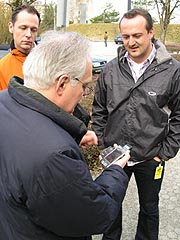
download digital graffities (pdf; 2,1 MB)
top of page
Dr. Bürgy
Wearable computers in hindsight and foresight:
application scenarios for applied wearable computing
Wearable computers and wearable electronics constitute the interface between humans and their surrounding ubiquitous computing environment. By wearing IT technology, we gain direct and consistent access to information and communication networks without having to utilize additional devices. Based on this constant knowledge of the environment, location-based applications are the key driver for wearable IT technology.
This presentation will discuss definitions and application scenarios of wearable computers and wearable electronics, showing meaningful examples of different device and application classes. Furthermore, the speaker describes the necessary technology to introduce such systems and gives a prediction on usage scenarios of upcoming applications for wearable technology.
download (pdf; 2,2 MB)
application scenarios for applied wearable computing
top of page
Host: Konietzny, xinober
Location based art projects
download the story of mobile expereince (ppt; 4,2 MB)
top of page
Aram Bartholl
Position zum Thema Location Based Services
Aram Bartholl setzt sich seit seiner Diplomarbeit „Daten am Ort“, welche eineForschungsarbeit über die mögliche Verbindung von Daten und Raum ist und den 1.Preis beim Browserday-Wettbewerb 2001 gewonnen hat, mit dem Thema Location Based Services auseinander. Sowohl als freiberuflicher Konzepter als auch in freien Künstlerischen Projekten arbeitet er an Visionen und Szenarien zu mobilen ortsbezogenen Datendiensten auf unterschiedlichster Ebene. Als freier Mitarbeiter in einer Kooperation des Fraunhofer Instituts FOKUS und der Firma City&Bits entwickelt Aram Bartholl für das Projekt „Mein Coburg“ Ideen für eine digitale Infrastruktur der Stadt Coburg. In seinen künstlerischen Arbeiten verfolgt er in verschiedenen Projekten einen „Lowtech“-Ansatz zum Thema Location Based Services. Wie lassen sich ortsbasierte Anwendungen, die technisch hochkomplex sind und kostenintensive Hardware voraussetzen mit einfachen Mitteln und auf die eigentliche Funktion reduziert umsetzen?
Relevante Fragen und Themen rund um Locative Media:
- Interfaces:
Was gibt es für Alternativen zu kleinen Screens mit kleinen Knöpfen?
- Akzeptanz:
Welche Applikationen werden vom User angenommen?
- Big Brother:
Wie entwickelt sich die Diskussion um Privatsphäre und Transparenz?
- Public Space:
Welche Rolle spielt Locative Media im Öffentlichen Raum?
- Sichtbarkeit:
Auf welche Art und Weise werden verortete Daten im Raum sichtbar?
- Web 2.0:
Welchen Einfluss hat die Entwicklung von Web 2.0 auf Locative Media?
top of page
Taeyoon Choi
Shoot me if you can, Seoul
watch movie shoot me, if you can (wmv; 10 minutes)
top of page
Dr. Uwe-Carsten Fiebig
New service opportunities with Galileo
The talk gives an overview of the European satellite navigation system Galileo presenting system concept, space segment and service categories. The main focus of the talk is on the advantages of Galileo over today’s GPS stimulating a large number of new services including mass market, commercial and safety of life applications.
download on Galileo (pdf;1,0 MB)
top of page
